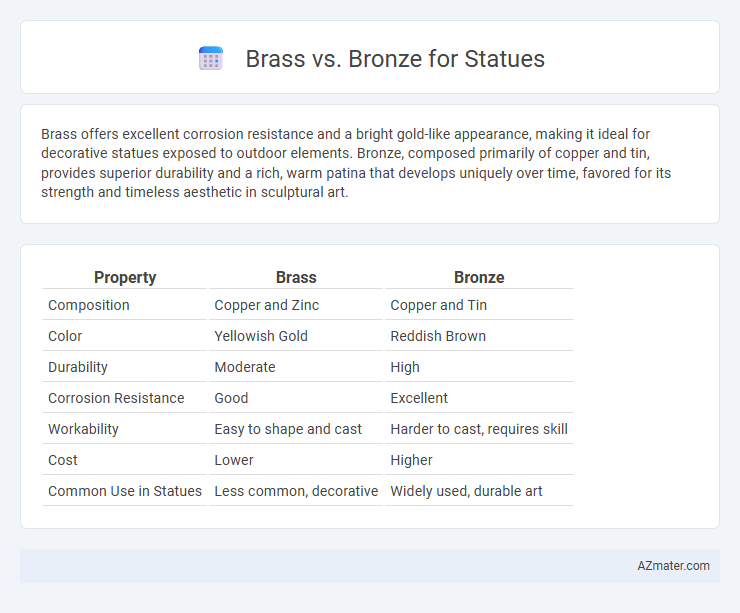Brass offers excellent corrosion resistance and a bright gold-like appearance, making it ideal for decorative statues exposed to outdoor elements. Bronze, composed primarily of copper and tin, provides superior durability and a rich, warm patina that develops uniquely over time, favored for its strength and timeless aesthetic in sculptural art.
Table of Comparison
| Property | Brass | Bronze |
|---|---|---|
| Composition | Copper and Zinc | Copper and Tin |
| Color | Yellowish Gold | Reddish Brown |
| Durability | Moderate | High |
| Corrosion Resistance | Good | Excellent |
| Workability | Easy to shape and cast | Harder to cast, requires skill |
| Cost | Lower | Higher |
| Common Use in Statues | Less common, decorative | Widely used, durable art |
Introduction to Brass and Bronze Statues
Brass and bronze are popular materials for statues due to their durability and aesthetic appeal, each offering distinct characteristics in sculpture. Brass, an alloy of copper and zinc, provides a bright, golden-yellow appearance, while bronze, primarily a copper and tin alloy, offers a richer, brownish tone with excellent corrosion resistance. Artists often choose bronze for detailed statues because its hardness allows for fine craftsmanship, whereas brass is favored for its vibrant color and malleability.
Historical Use of Brass and Bronze in Sculpture
Bronze, an alloy primarily of copper and tin, boasts a rich history in sculpture dating back to ancient civilizations like the Greeks and Chinese, valued for its durability and ability to capture fine details. Brass, composed mainly of copper and zinc, emerged later as a popular alternative, appreciated for its bright gold-like appearance and resistance to corrosion in outdoor settings. Sculptors historically favored bronze for monumental statues due to its strength and traditional patina, while brass found use in decorative art and smaller figures for its aesthetic appeal and lower cost.
Composition and Material Properties
Brass is an alloy primarily composed of copper and zinc, known for its bright gold-like appearance and excellent corrosion resistance, making it suitable for statues exposed to outdoor environments. Bronze consists mainly of copper and tin, offering superior hardness and durability, with a characteristic darker, reddish-brown color favored for classical sculptures. The distinct material properties--brass's malleability and bronze's strength--determine their specific applications in statue crafting and preservation.
Aesthetic Differences: Color and Finish
Brass statues exhibit a bright, golden-yellow hue with a smooth, reflective finish that enhances intricate details and adds a warm, radiant aesthetic. Bronze statues display a deeper, reddish-brown tone with a matte or satin finish, offering a classic, antique appearance that ages gracefully with a natural patina. The contrasting colors and finishes influence the statue's visual impact, with brass providing a more vibrant and modern look while bronze conveys timeless elegance and historical resonance.
Durability and Weather Resistance
Brass exhibits moderate durability and good resistance to corrosion, making it suitable for indoor statues but less ideal for prolonged outdoor exposure due to potential tarnishing. Bronze, an alloy primarily of copper and tin, offers superior durability and exceptional weather resistance, forming a stable patina that protects it from environmental elements over time. This makes bronze the preferred material for outdoor statues, ensuring long-lasting structural integrity and aesthetic appeal.
Workability for Sculptors
Brass offers superior malleability and a lower melting point compared to bronze, making it easier for sculptors to shape intricate details and perform fine finishing work. Bronze, composed primarily of copper and tin, provides greater hardness and durability but can be more challenging to work with due to its higher melting point and brittleness during cooling. Sculptors often choose brass for detailed, delicate statuary while preferring bronze for larger, more robust pieces requiring long-lasting structural integrity.
Cost Comparison: Brass vs Bronze
Brass generally costs less than bronze due to its lower copper content and the use of zinc as the primary alloying element, making it a budget-friendly option for statue casting. Bronze, composed mainly of copper and tin, tends to be more expensive but offers superior durability and corrosion resistance, which can justify the higher initial investment over time. When choosing between brass and bronze for a statue, consider both the upfront material cost and the long-term maintenance expenses to determine the most cost-effective option.
Maintenance and Longevity
Brass statues require regular cleaning to prevent tarnish and corrosion, especially in outdoor environments, while bronze develops a protective patina that enhances durability and reduces maintenance needs over time. Bronze's superior resistance to weathering and oxidation makes it the preferred choice for long-lasting statues exposed to the elements. Maintenance costs for bronze statues are generally lower due to their natural ability to withstand environmental damage compared to brass.
Popular Examples of Brass and Bronze Statues
The Statue of Liberty, made of copper over an iron framework but often associated with bronze due to its patina, exemplifies the enduring use of bronze in monumental sculptures for its corrosion resistance. Brass statues, such as the famous brass Buddha statues found across Asia, highlight the material's appeal for intricate detailing and warm golden hue. Both metals have made notable contributions to cultural heritage through iconic statues like the bronze charging bull on Wall Street and brass figurines in traditional craftsmanship.
Choosing the Right Material for Your Statue
Brass, an alloy of copper and zinc, offers a bright gold-like appearance and excellent malleability, making it ideal for intricate statue designs requiring a shiny finish. Bronze, composed primarily of copper and tin, provides superior durability and a rich, warm patina that develops over time, enhancing the statue's aesthetic and weather resistance. Selecting the right material depends on the desired visual effect, environmental exposure, and longevity requirements for the statue's placement.

Infographic: Brass vs Bronze for Statue
 azmater.com
azmater.com